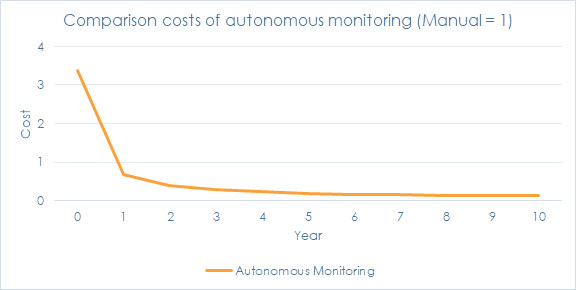 The volume of tailings release due to dam failure has been trending upwards since the 1970s with quantities of material released reaching an average of over three million cubic meters per failure since 2010.
The volume of tailings release due to dam failure has been trending upwards since the 1970s with quantities of material released reaching an average of over three million cubic meters per failure since 2010.
 Whilst total numbers of dam failures have generally fallen from the 1960s, as mine sites have grown in scale, due to the mechanisation of more processes and the increased capacity of equipment, the scale of the failure has steadily increased.
Whilst total numbers of dam failures have generally fallen from the 1960s, as mine sites have grown in scale, due to the mechanisation of more processes and the increased capacity of equipment, the scale of the failure has steadily increased.
Consequently, the need for monitoring of tailings storage facilities has become more important to prevent:
- downstream loss of life,
- ecological disaster, and
- operational disruption.
Monitoring plans are invariably required by mining regulators as part of their licence to operate and environmental bonds are sized according to a mine’s monitoring system.
Tailings dams are inevitably the largest “legacy” structure remaining onsite post-mine closure. Dam wall construction has varied over time and as mines expand production or extend their mine life, dam walls are required to be raised to increase their storage capacity.
The Brumadinho dam wall, which failed recently in Brazil, was constructed using the “upstream method” by which approximately half of the 3,500 dams worldwide are constructed .
Manual Monitoring Exposes Risk
Monitoring processes have varied from manually measuring a dam wall position, the installation of downhole instrumentation to measuring pore pressures or the monitoring of crack structures.
Typically, these activities are periodically undertaken with manual techniques that require personnel to be in the field, increasing the risk of fatigue or injury.
Furthermore, as the mine site grows, surveying crews are inevitably placed under more operational pressure and routine monitoring tasks can be at risk of falling by the wayside.
Autonomous monitoring solutions
 Alternatives to manual methods include the application of a wireless, autonomous, near-real time monitoring system that replaces the need to manually measure points with either GNSS or total stations. Furthermore, the cost to the operation, whilst higher in the short term with capital expenditure, is rapidly offset in subsequent periods with only minimal labour and data transfer required .
Alternatives to manual methods include the application of a wireless, autonomous, near-real time monitoring system that replaces the need to manually measure points with either GNSS or total stations. Furthermore, the cost to the operation, whilst higher in the short term with capital expenditure, is rapidly offset in subsequent periods with only minimal labour and data transfer required .
The benefits of wireless systems are primarily associated with the ease of installation. Senceive’s Flatmesh method of communicating preserves the data pathways between the sensors with only part of the system required to see the gateway.
Once installed, conducting work activities around the system is facilitated by the absence of cabling and temporary obstructions are resolved by the system’s ability to self-heal data pathways from the instruments to the gateway.
Autonomous systems allow maintenance-free monitoring activities to proceed with little to no input required. The time needed to manually survey into the area is eliminated, as is the time required to traverse to a monitoring location or acquire satellites to measure points using GNSS.
More data, more insights
 Autonomous systems, particularly Senceive’s with long-life batteries, are also advantageous as measurements can be taken at relatively short observation frequencies, typically at 30 minutes, over a period of up to 15 years. Not only does this provide the opportunity to observe movements in small increments, it also shows how a structure moves over a daily period, typically with temperature. Understanding the daily cyclical movement provides context behind drifting trends or sudden variations of tilt.
Autonomous systems, particularly Senceive’s with long-life batteries, are also advantageous as measurements can be taken at relatively short observation frequencies, typically at 30 minutes, over a period of up to 15 years. Not only does this provide the opportunity to observe movements in small increments, it also shows how a structure moves over a daily period, typically with temperature. Understanding the daily cyclical movement provides context behind drifting trends or sudden variations of tilt.
Near-real time systems can provide alerts to key personnel when thresholds are exceeded or when sensors have not been connected to the gateway for a short period of time. Whilst default observation frequencies can be changed, functionality also exists to “wake” a sensor up if a critical threshold is exceeded.
Tilt systems can be integrated with other geotechnical and downhole instrumentation such that the entire system can report to the same platform. In situ pore pressures within a dam wall can be measured with a vibrating wire piezometer and the data can be wirelessly collected by the same gateway in the field. Further afield, instruments such as crack sensors and displacement sensors can also be integrated.
Tailings dam monitoring can be undertaken many ways. Only an autonomous near-real time system can both reduce the risk of failure and enhance productivity.
Article supplied by AIMS Sponsor - Position Partners
Image Source: https://en.wikipedia.org/wiki/Brumadinho_dam_disaster
Other references:
http://www.wise-uranium.org/mdaf.html
http://www.mpi.org.au/2014/08/chronology-of-major-tailings-dam-failures/
https://worldminetailingsfailures.org/
http://www.tailings.info/disposal/conventional.htm








